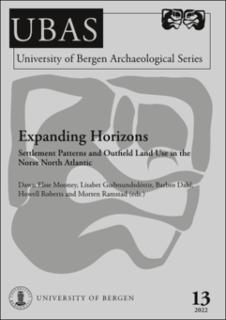| dc.contributor.author | Mooney, Dawn Elise | |
| dc.contributor.author | Guðmundsdóttir, Lísabet | |
| dc.contributor.author | Dahl, Barbro Irene | |
| dc.contributor.author | Roberts, Howell | |
| dc.contributor.author | Ramstad, Morten | |
| dc.date.accessioned | 2023-03-16T09:15:31Z | |
| dc.date.available | 2023-03-16T09:15:31Z | |
| dc.date.created | 2022-12-14T09:54:57Z | |
| dc.date.issued | 2022 | |
| dc.identifier.citation | Mooney, D. E., Guðmundsdóttir, L., Dahl, B., Roberts, H., & Ramstad, M. (2022). Expanding horizons in North Atlantic archaeology. In: Mooney, D. E., Guðmundsdóttir, L., Dahl, B., Roberts, H. & Ramstad, M. (eds.), Expanding Horizons : Settlement Patterns and Outfield Land Use in the Norse North Atlantic, 13-24. | en_US |
| dc.identifier.isbn | 978-82-8436-005-8 | |
| dc.identifier.uri | https://hdl.handle.net/11250/3058646 | |
| dc.description.abstract | From the 9th century AD onwards, Norse migration resulted in the spread across the North Atlantic of cultural traits originating in Norway. Although these colonies were dispersed over islands scattered across thousands of kilometres of open ocean, they remained politically and culturally interlinked. Moreover, these islands share much with western Norway in terms of climate, landscape and topography, being characterised by heathland and mountain areas, including glaciers and ice caps, bordered by relatively small areas of land suitable for agriculture mainly along the coasts and in sheltered fjords and valleys. These challenging landscapes rewarded resilience and adaptability, as evidenced by complex subsistence strategies including pastoralism, transhumance, hunting and fishing, alongside arable agriculture. However, although the significance of these elements varied both over time and at local and regional scales, this variability itself has so far been little understood. Although much data addressing such research questions has been, and continues to be, generated through archaeological surveys, development-led excavations, and research projects, this information is often inaccessible: overview publications are lacking, and results are often presented only in unpublished reports. Furthermore, there has been relatively little collaboration between archaeologists in western Norway and the North Atlantic, partly due to separation between research and development-led archaeology, and to differing approaches and methodologies across the region. The Expanding Horizons project aimed to provide a means to address these issues by drawing together junior and senior practitioners in archaeology and related fields, from both within and outside of academia, to present their work. Two workshops, in Norway in 2018 and in Iceland in 2019, brought together researchers and practitioners from Europe and North America to share their ideas, methods and results, and explore common problems and goals. | en_US |
| dc.language.iso | eng | en_US |
| dc.publisher | Universitetet i Bergen | en_US |
| dc.relation.ispartof | Expanding Horizons: Settlement Patterns and Outfield Land Use in the Norse North Atlantic | |
| dc.rights | Navngivelse 4.0 Internasjonal | * |
| dc.rights.uri | http://creativecommons.org/licenses/by/4.0/deed.no | * |
| dc.title | Expanding Horizons in North Atlantic Archaeology | en_US |
| dc.title.alternative | Expanding Horizons in North Atlantic Archaeology | en_US |
| dc.type | Chapter | en_US |
| dc.description.version | publishedVersion | en_US |
| dc.rights.holder | The authors | en_US |
| dc.subject.nsi | VDP::Humaniora: 000::Arkeologi: 090 | en_US |
| dc.source.pagenumber | 13-24 | en_US |
| dc.identifier.cristin | 2092884 | |
| dc.relation.project | Universitetet i Stavanger: IN-11355 | en_US |
| cristin.ispublished | true | |
| cristin.fulltext | original | |

